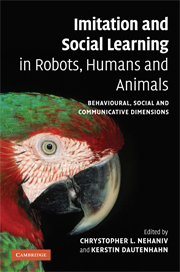 Imitation and Social Learning in Robots, Humans and Animals
Imitation and Social Learning in Robots, Humans and Animals Published online by Cambridge University Press: 10 December 2009
Social learning and behaviour matching are prevalent and important in learning by animals and humans. But as we saw in the section on correspondence problems and mechanisms, there are many possibilities for what aspects of an observed behaviour an individual may attempt to match. This is the problem of ‘what to imitate?’ and has been identified as amongst the big five problems for the study of social learning (Dautenhahn and Nehaniv, 2002). This is of course closely linked to the question ‘why imitate?’ as it potentially requires discussion of the internal motivational states that cannot be directly observed by the social learner (see Part VI, Why imitate? – Motivations, this volume).
In this section, three very different constructive approaches toward solving this problem are put forth by ethologists Malinda Carpenter and Josep Call, roboticists Sylvain Calinon and Aude Billard, and artificial intelligence researchers Tony Belpaeme, Bart de Boer and Bart Jansen.
Malinda Carpenter and Josep Call approach the problem of what to imitate in artificial constructed systems from an ethologist's viewpoint. With reference to studies of primates, especially human children, and other animals including birds and dolphins, they present an illuminating survey of several different ways in which an observer might infer the goals or sub-goals of an observed behaviour.
To save this book to your Kindle, first ensure no-reply@cambridge.org is added to your Approved Personal Document E-mail List under your Personal Document Settings on the Manage Your Content and Devices page of your Amazon account. Then enter the ‘name’ part of your Kindle email address below. Find out more about saving to your Kindle.
Note you can select to save to either the @free.kindle.com or @kindle.com variations. ‘@free.kindle.com’ emails are free but can only be saved to your device when it is connected to wi-fi. ‘@kindle.com’ emails can be delivered even when you are not connected to wi-fi, but note that service fees apply.
Find out more about the Kindle Personal Document Service.
To save content items to your account, please confirm that you agree to abide by our usage policies. If this is the first time you use this feature, you will be asked to authorise Cambridge Core to connect with your account. Find out more about saving content to Dropbox.
To save content items to your account, please confirm that you agree to abide by our usage policies. If this is the first time you use this feature, you will be asked to authorise Cambridge Core to connect with your account. Find out more about saving content to Google Drive.